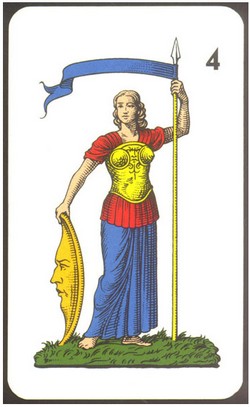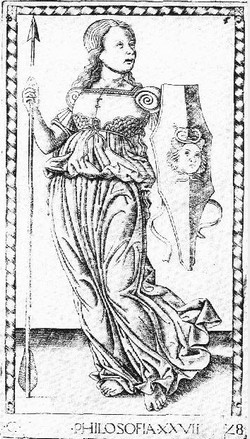New Documents from Palermo
by Franco Pratesi, 1992
(from: The Playing-Card, Vol. XXI, No. 1, 9-15.)
|
It is not easy to find something new concerning cards and card playing in Sicily. There are two main reasons for that, the objective lack of documents and the pioneering interest to the topic by Michael Dummett. Not to mention his remarkable contributions from oral witnessess, it is unlikely that any relevant archival evidence has escaped his attention! Nevertheless, I could recently study in some public Libraries and in Archivio di Stato of Palermo a few documents which provide further useful information. Archivio di StatoHere are kept the already known impressions of wooden and copper blocks for Sicilian cards (Misc. I n.225); a 1846 edition of Chitarrella rules for mediatore and tresette (Misc. II n.212); some bandi, as that of Ferdinando II dated Naples 10.12.1844 (Misc. II n.654) - Four kinds of cards are allowed: Carte ordinarie, Italiane fine, Francesi, Tarocchi. They have to be stamped in colour in Palermo with 3 gigli semplici (fleurs-de-lys) under the royal crown. The mark must be on the 2 spades for French cards and 5 swords in the others; the duty will be of 4 Neapolitan grana for each kind; moreover the price for the sheet will be 3 grana for ordinarie and 6 for others. The makers will print their names on a card of each pack.
A page toward the end of the file keeps the names of card makers in Palermo. Due to the interest of the Cimino family, it is reported here in full (only neglecting the Sig. before the names of the Masters and Sig.a D.a before the Pincitrici or women card painters).
The presence of members of the same family is evident in several cases, even though no further indication can be deduced as the actual leading ones. Taken as a whole, the 48 persons involved can be compared with the 76 before mentioned for Naples.
 Nr 1325 (1830). Here are kept several monthly letters about the situation of the incomes. Unfortunately for us, the bureaucracy has made its own choice as regards the material to be preserved. The usual procedure is to send a letter together with a sheet of tables summarising the actual situation. Already in the letters, the joined material is stated as something shipped for any use chosen by the receiver, and he or his office has systematically chosen that the sheets were not worth preserving. Obviously, for us this represents the worst choice. Much better would it have been if the letter had been thrown and the tables preserved. Month after month the situation repeats itself, only changing slightly the forms in the accompanying letters: "ne farà l’uso che le aggraderà", "per servirsene all’uso conveniente", and so on.Nr 1396 (1833) Nr 1496 (1835). It contains two big files in which I have found nothing concerning cards. A fact that has occurred for other files in the following, where I will write briefly, "nothing on cards". Here the records are mostly applications for 29-days leaves of absence, customs questions, and so on. Nr 1721 (1842). Apart from some initial sheets for the year 1842, most of the remaining documents are from about 1833. Felice Montuoro and Mariano Buonocore arrendieri, i.e. holders of the tax contract, suggest a different procedure for shipping the sheets from Palermo to Naples and vice versa. There are several questions of smuggling and stocks. These documents are mixed with others concerning tobaccos. Nr 1781 (1844). There is a file, about 10 cm thick, devoted only to cards. There are thus many documents concerning solicitations, information on changes of the system and so on. Predominant are questions of stamp shapes and duties. The corresponding dates are various, mostly 1826-38. The impression is that before assuming a new rule, all the relevant documents of the previous years have been collected here. There are also several copies of contracts or arrendamenti. Let us limit ourselves to the examination of a few documents. A leaflet on coloured paper of 29.1.1838 reports the kind of cards and prices (old and new, respectively in the two columns) in grana: 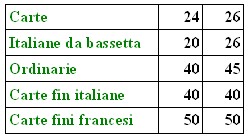 Nr 2028 (1851). The file has many documents about the ports and others concerning rents. Nothing on cards. Nr 2086 (1852). Two big files, the first essentially of small expenses, the second of rents. Nothing on cards. Nr 2132 (1853). The file about playing cards is 2 or 3 cm thick and contains material for the year 1853. There are several documents concerning the visit of an inspector in Modica. A leaflet with yellow cover printed in Palermo in 1845 contains the Real Decreto sulle carte da gioco dated Naples 10.12.1844 and the following Regolamento di servizio dated 31.5.45. These are laws valid for Sicily promulgated by King Ferdinando II. The cards are divided into four kinds: 1. ordinarie, 2. italiane fini, 3. francesi, 4. tarocchi. Card makers need a licence and the same holds for the sellers. There are some discussions about a supposed decrease in incomes from taxes and in answer some comparisons with previous years are submitted by the offices. The following table of incomes derives from two documents; the more recent is dated 10.8.1853 and does not report the values for 1850. Most values are coincident. 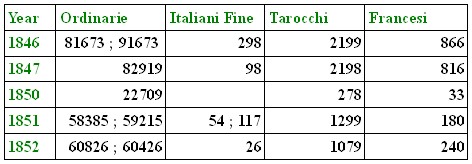 Apart from the slight differences between the two reports, the situation is clear. Italiane fini and francesi were only a negligible amount, whereas Tarocchi were still in use, providing about 2% of the total income.  BIBLIOTECA COMUNALELet us now pass to Biblioteca Comunale, located inside the imposing palace of Jesuits. Among other things of interest, here are kept the manuscripts by Emaneuele e Gaetani Marchese di Villabianca. While verifying the passage on Sicilian tarot studied by Prof Dummett, I found two scarce books which may be of some interest for the experts. Il Giuoco dei Tarocchi moralizzato da D.G.P.The first book contains several leaflets bound together. The first booklet is the relevant one here. It is a 4 leaf booklet without date and printer. The dates of the other leaflets are Palermo 1736, Siena 1786, Palermo 1798, Palermo 1794, Palermo 1794, Palermo sd. Thus, a date in the second half of the XVIII would be tentatively suggested, even if a date toward the beginning of the 18th century still appears likely.Il Giuoco dei Tarocchi moralizzato da D.G.P. The author (likely a Jesuit himself) begins his work with some historical references to "alea" games, as supposedly invented by Lidians, Troians or Egyptians. Brief quotations follow from late-Renaissance writers such as Lilio Gregorio Girardi, Francesco Patrizio, Angelo Rocca. Moreover, references are provided also from the ancient philosophers and poets as Plato and Petrarca and particularly the Fathers of the Church (Agostino, Cipriano, Basilio, Giovanni Crisostomo, Antonino, Bernardino da Siena, Tommaso, Francesco Borgia). Finally, the author quotes more recent contributions by Baldassare Cavasio and Paolo Segneri. The conclusion is that a difference has to be acknowledged between professional gamblers and occasional players. Then the author enters the tarot question - the game is common but the cards are odd and a better series can be suggested in substitution.
Then the author describes the other triumphs as invented by him (for numbers and names see first columns in table below, where the last column reports - apart from Fuggito, as named here - the traditional names according to M.Dummett. The author adds for each card a typical Latin motto, here reported in the mid column of the table. 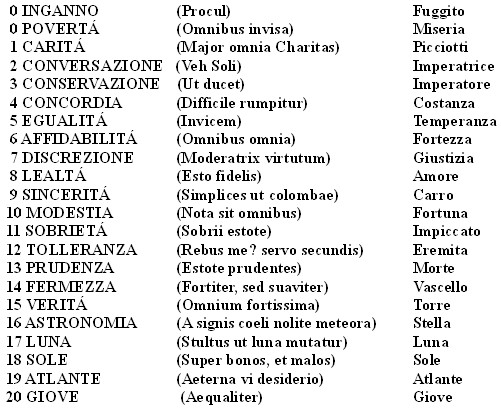 It may be noted that the highest cards are the most similar to the Sicilian conventional ones. Very interesting is the presence of the "typical" 22 triumphs, instead of the 21 Sicilian ones. In fact, below the 20 numbered cards corresponding more or less precisely to the Sicilian sequence, we have two lower cards, i.e., Inganno and Povertà. Il Tesoro dei perditempoThe second scarce book is more recent but it appears to have escaped due attention by experts too (to begin with A.Lensi who does not include it in his well known bibliography): "Il Tesoro dei perditempo - ossia Raccolta dei più dilettevoli giuochi di carte pel divertimento di più persone nelle società numerose per cura d’un sfaccendato con l’aggiunta d’un trattato sul giuoco del whist". Palermo. Stabilimento tipografico di Fr. Lao. 1859. 112p.It describes many card games which seem to derive from the French Academies des jeux, even though they are commonly "translated" to the 40-cards pack. Moreover, it reports some independent descriptions of games, among which an original description of trionfi. The game of trionfi has a great history. However, its descriptions in the common "complete" books of card games are very scant and unsatisfactory. They either derive from foreign texts or only summarise the rules, so that it becomes impossible to reconstruct the game. Therefore, let us outline here the rules as recorded in this new source.
BIBLIOTECA REGIONALEIt may finally be noted that Biblioteca Regionale, the richest in Palermo, also keeps documents worth inspecting. For instance, there is a rare poem on the game of Scopone published in 1925 by S.Grisafi and a dissertation by S.Barberi "Il giuoco delle carte in Italia" discussed in Palermo University in 1945. In the manuscript section, a printed specimen of the Bando of 22.3.1625 about cards and gambling in Sicily is preserved. It forbids dice games and permits board ones. Card games must be played with stamped cards; two such games, cartetta svolta and quaranta are forbidden in any case. Apart from private collections, there are in Palermo at least two further libraries which I could not visit but which should be inspected by card researchers; namely, those of Deputazione di Storia Patria and Museo Pitré. Side bar pictures and text added by Lothar Teikemeier Pictures:
|
|

